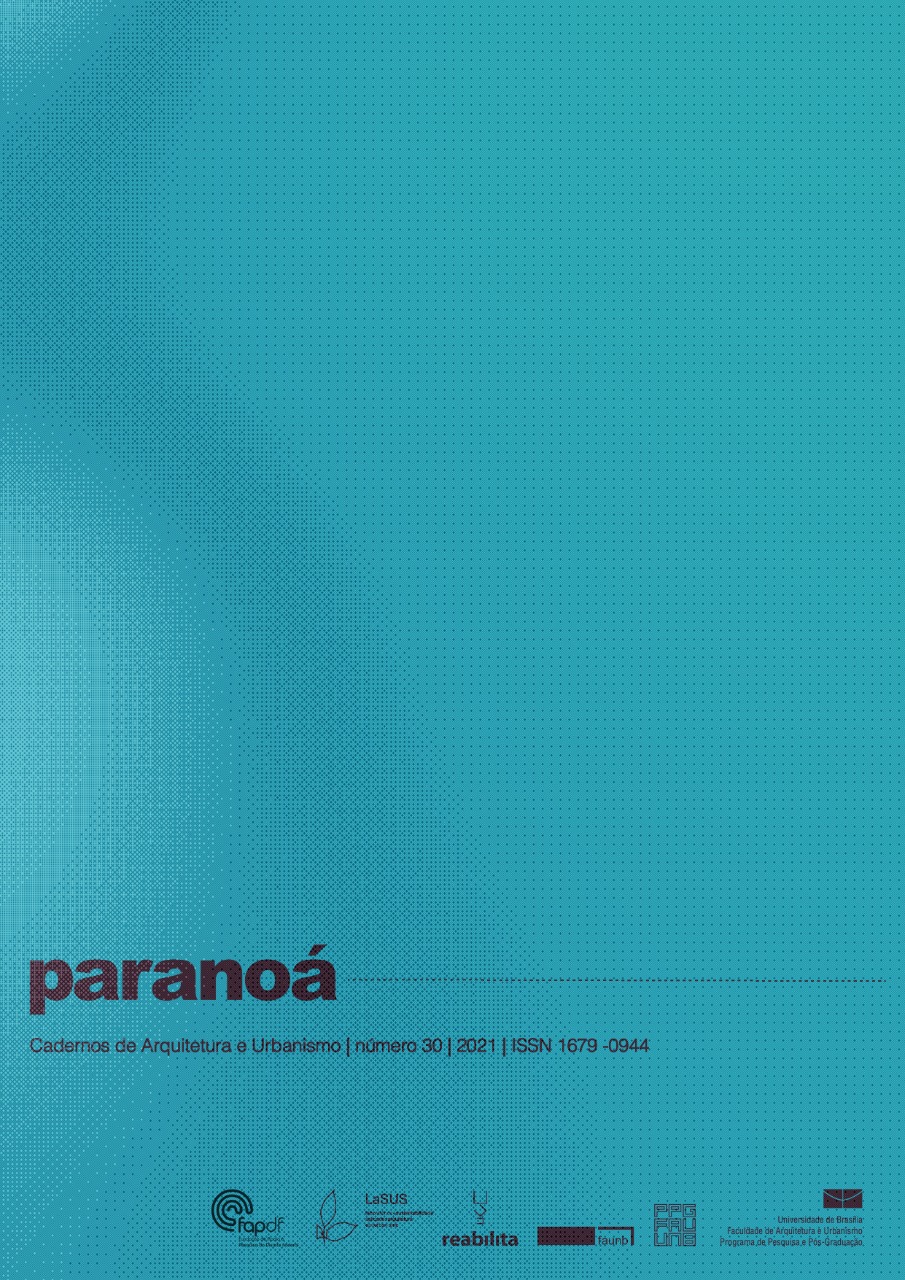Vegetation importance on the urban planning of Quito, Ecuador
DOI:
https://doi.org/10.18830/issn.1679-0944.n30.2021.15Keywords:
Árboles, temperatura, sombra, enfriamiento, radiación.Abstract
When heat island effect is the concern, urban areas are more impacted by this phenomenon than rural and natural landscapes. Land cover greatly influences on the emergence of heat islands, which has expanded in cities across the world. Green infrastructure is one of the most effective cooling tools available in cities for mitigating heat island effects. In this scenario, Quito is a city that experiences a very high solar radiation index due to its geographic location and latitude, and this study aimed to investigate the effects of green infrastructure on sun exposure and comfort level of Quito inhabitants. The study was based on information available in the literature and gathered data of El Ejido park from Guarderas, Cohello and Silva (2016), who used representative tree species of El Ejido park to evaluate their effect on microclimatic regulation. It turned out that under tree shade the temperature under Quito climate conditions decreased 2oC, the relative humidity was lower than in open areas and the intensity of light was almost half that of measured in the open areas. It was concluded that trees contributed to regulate the urban microclimate in Quito.
Downloads
References
CARLOS FERNANDO LÓPEZ ORDÓÑEZ, JAUME ROSET CALZADA Y GILKAURIS MARÃA ROJAS CORTORREAL, Análisis de la radicación solar directa en las calles de Barcelona, en base a la relación entre su morfología y vegetación. Fecha de consulta: dd-mm-aa. En: ACE: Architecture, City and Environment = Arquitectura, Ciudad y Entorno, 12 (34): 45-68, 2017.
FARSHID ARAM, ESTER HIGUERAS GARCÃA, EBRAHIM SOLGI, SORAN MANSOURNIA. Urban green space cooling effect in cities. Heliyon 5, 2019.
PAULINA GUARDERAS, MARCELA COELLO, XAVIER SILVA, El efecto de los árboles urbanos del parque El Ejido en la regulación del microclima de Quito: interacción entre medio ambiente, salud y bienestar. Carrerea de Ciencias Biológicas y Ambientales, Facultad de Ciencias Biológicas, Universidad Central del Ecuador. Rev Fac Cien Med, Quito, 2016.
LUCA SZÁRAZ, The Impact of Urban Green Spaces on Climate and Air Quiality in Cities. Swedich University of Agricultural Sciences. Nobiembre 2014.
JAMSHID DAVTALAB, SHAHRAM POOR DEYHIMI, VALENTINA DESSI, MOHAMMAD REZA HAFEZI, MORTEZA ADIB, The impact of green space structure on physiological equivalent temperature index in open space, marzo 2020.
JENNIFER R. WOLCH, JASON BYRNE, JOSHUA P. NEWELL, Urban green space, public health, and environmental justice: The challenge of making cities ‘just green enough. Mayo 2014.
GORDON B. BONAN, SAMUEL LEVIS, LAURENT KERGOAT, KEITH W. OLESON, Landscapes as patches of plant functional types: An integrating concept for climate and ecosystem models. Mayo 2002.
LUIS HERNANDES, MILTON ARCINIEGAS, Consultoría CDA-SA-007-2014: Implementación de la primera fase del mapa de ordenamiento forestal en las ACUS y AIER como parte del proceso de fortalecimiento a la aplicación del Modelo de Gestión Forestal en el DMQ. Secretaría del Ambiente. Quito 2015.
MARTHA ADRIANA BUSTOS ROMERO, Principios bioclimáticos para o desenho urbano. 2000.
MARTHA ADRIANA BUSTOS ROMERO, Arquitetura do lugar ”“ Uma visao bioclimática da sustentabilidade em Brasilia. 1ra Ediçao, Sao Paulo 2011.
VICTOR OLGYAY, Arquitectura y Clima ”“ Manual de diseño bioclimático para arquitectos y urbanistas. Cuarta tirada 2006.
MUNICIPIO DEL DISTRITO METROPOLITANO DE QUITO, Los Árboles Patrimoniales de Quito- SEGUNDA EDICIÓN. Enero, 2018.
NIXON NARVAEZ, SANDRA JIMENEZ, Atlas Ambiental Quito sostenible 2016. Municipio del Distrito metropolitano de Quito ”“ Secretaría del Ambiente ”“ Centro de transferencia de Tecnológia USFQ. ISBN: 978-9942-8545-4-4. 2016.
SECRETARIA DE TERRITORIO, HABITAT Y VIVIENDA ”“ DIRECCIÓN METROPOLITANA DE DESARROLLO URBANISTICO. Red verde urbana ”“ Documento técnico. Quito 2014.
JUAN JAVIER NICHOLLS ANDRADE, La ciudad y sus árboles: Estudio de caso de los barrios quiteños a través de sus imaginarios. Facultad Latinoamericana de Ciencias Sociales, FLACSO Ecuador Departamento de Asuntos Públicos. Tesis para maestría en Estudios Urbanos. Marzo 2018.
INSTITUTO NACIONAL DE ESTADISTICAS Y CENSOS INEC, Ãndice verde urbano 2012. Disponible en: https://www.ecuadorencifras.gob.ec/documentos/web-inec/Encuestas_Ambientales/Verde_Urbano/Presentacion_Indice%20Verde%20Urbano%20-%202012.pdf
WORLD HEALTH ORGANIZATION, Urban green Spaces: A brief for action. Regional Ofice for Europe, 2017. Disponible en: https://www.euro.who.int/__data/assets/pdf_file/0010/342289/Urban-Green-Spaces_EN_WHO_web3.pdf?ua=1
ECU RED, Transìracion de las plantas. Disponible en: https://www.ecured.cu/Transpiraci%C3%B3n_en_las_plantas
PNUD ECUADOR. Habitat III, Quito 2016. Disponible en: https://www.ec.undp.org/content/ecuador/es/home/presscenter/articles/2016/10/14/habitat-iii-ecuador-quito.html
---------, Análisis Arquitectónico de los efectos de la vegetación en los espacios exteriores urbanos. Disponible en: https://www.tdx.cat/bitstream/handle/10803/6124/05JMot05de12.pdf;jsessionid=32FE80B428B129B28AA2A825585CDC09?sequence=5
HAMED MEHDIPOOR, Physiological equivalent temperature, Junio 2017. Disponible en: https://www.biomet-education.net/glossary/physiological-equivalent-temperature/
TREEPEDIA, Exploring the Green canopy in cities around the world. Disponible en: http://senseable.mit.edu/treepedia
Downloads
Published
How to Cite
Issue
Section
License
Copyright (c) 2021 Paranoá: journal of Architecture and Urbanism

This work is licensed under a Creative Commons Attribution 4.0 International License.
Autores que publicam nesta revista concordam com os seguintes termos:
- Autores mantém os direitos autorais e concedem à revista o direito de primeira publicação, com o trabalho simultaneamente licenciado sob a Licença Creative Commons Attribution que permite o compartilhamento do trabalho com reconhecimento da autoria e publicação inicial nesta revista. http://creativecommons.org/licenses/by/4.0
- Autores têm autorização para assumir contratos adicionais separadamente, para distribuição não-exclusiva da versão do trabalho publicada nesta revista (ex.: publicar em repositório institucional ou como capítulo de livro), com reconhecimento de autoria e publicação inicial nesta revista.
- Autores têm permissão e são estimulados a publicar e distribuir seu trabalho online (ex.: em repositórios institucionais ou na sua página pessoal) a qualquer ponto antes ou durante o processo editorial, já que isso pode gerar alterações produtivas, bem como aumentar o impacto e a citação do trabalho publicado (Veja O Efeito do Acesso Livre).















